When you think about frogs, you immediately conjure images of leaping amphibians during rainfall or throughout the year along marshes, ponds, and other bodies of water. But you don’t promptly picture frogs climbing trees. These frogs typically have vibrant colors, which makes them a great zoo exhibit in contrast to their relatively dull terrestrial cousins.
Due to their nocturnal activity and unusual sounds, they are frequently heard in their natural habitat rather than seen. These frogs are most easily recognized by their feet, which have claw-shaped toe bones. As Texas boasts a vast topography that hosts a wide range of wildlife diversity, are there tree frogs in Texas?
Luckily for Texans, the Lone Star State is home to more or less 44 species of frogs, and 12 of them are tree frogs. However, don’t be misled by the label “tree frog,” as species in this family can also be terrestrial and semi-aquatic. Below, we list the 12 types of tree frogs found in Texas.
12 Types of Tree Frogs in Texas
1. Canyon Tree Frog
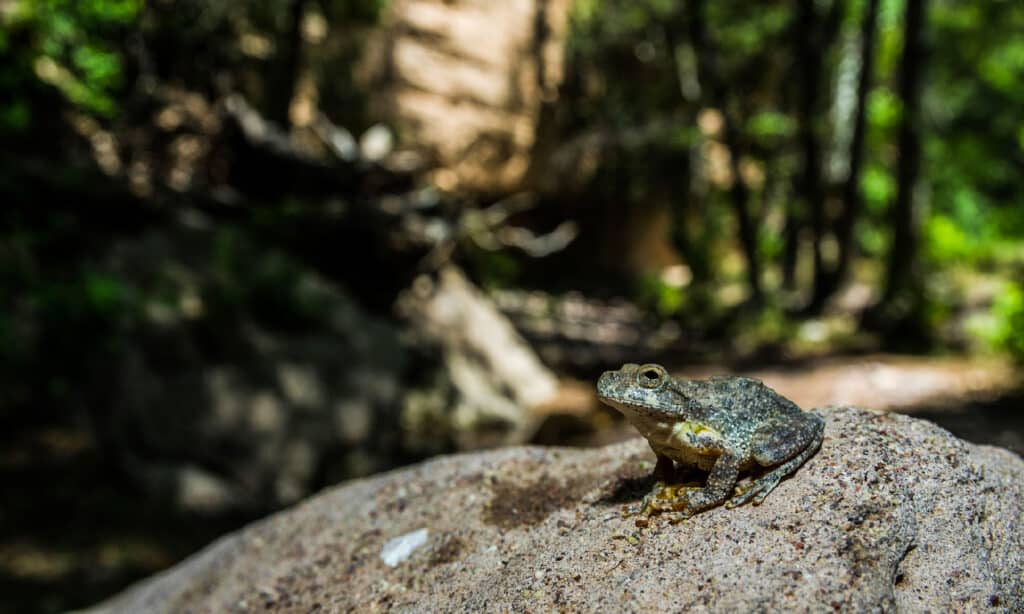
Canyon tree frogs are more active in cooler temperatures and will freeze if they come upon a predator.
©iStock.com/Timothy Cota
In Texas, rocky places are where you can find canyon tree frogs. Although they go by the name “tree frogs,” this species is most frequently observed perched on boulders, and rock faces close to perennial water sources. They are medium-sized, growing to a length of 2.2 inches, and come in shades of brown, gray, or green. They often blend in with the surroundings’ color scheme as well. Nocturnal canyon tree frogs depend on insects for food, and they spend more time hiding in cracks when the rainy season ends.
Canyon tree frogs take refuge in rock crevices during the hottest portion of the day and when it doesn’t rain much. To help prevent moisture loss, they occasionally congregate in these locations. These frogs are more active in cooler temperatures and will freeze if they come upon a predator.
2. Cope’s Gray Tree Frog
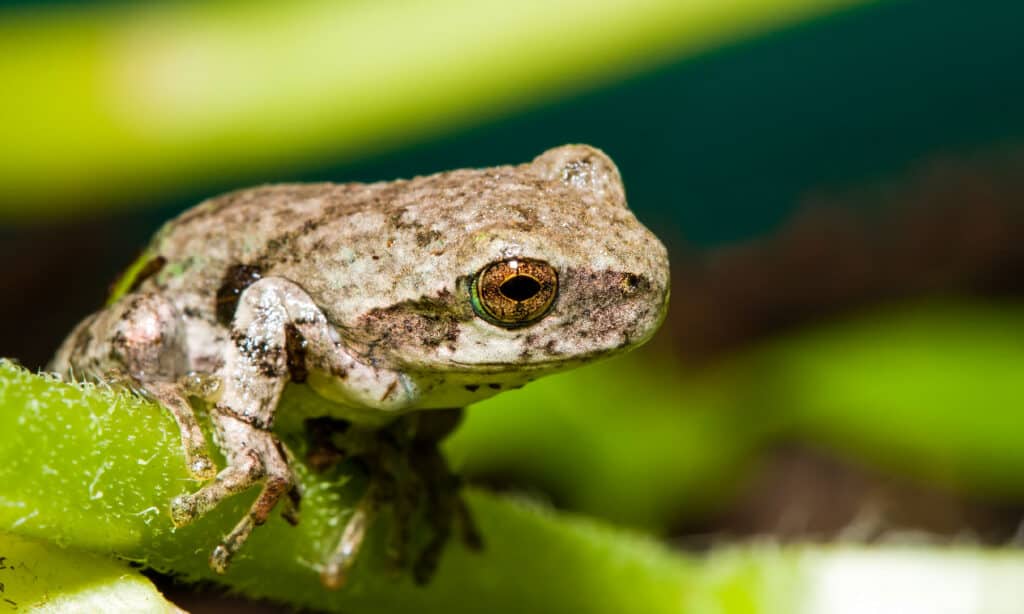
The Cope’s gray tree frog frequently resides in grasslands and swamps.
©iStock.com/Coffee999
The southern gray tree frog is another name for the Cope’s gray tree frog. These frogs have gray and gray-green coloring, and their appearance resembles tree bark. They live in Texas’ forests and woodland settings. They frequently reside in grasslands and swamps, although they also live in various settings close to water. Even though it has a slightly distinctive croak, the Cope’s gray tree frog looks like the common gray tree frog.
Their brilliant yellow and orange markings on the rear legs distinguish them from other tree frogs, and they have a quick, high-pitched call. They may react by running away or hiding beneath trash if they feel threatened.
3. Gray Tree Frog

Gray tree frogs can range in color from brown to gray.
©Aleksandr Kondratov/Shutterstock.com
One can find gray tree frogs in western Texas. The habitat of the gray tree frog is rich in trees and bushes. They can be found in many woody environments, including backyards, woodlands, and swamps. The gray tree frog can gradually alter its color to blend in with the surface it is perched on. The majority of their nocturnal activity involves climbing through plants. They can range in color from brown to gray and have black blotches, blunt noses, and warts all over their skin. They are drawn to the insects swarming the porch windows’ light.
4. Green Tree Frog
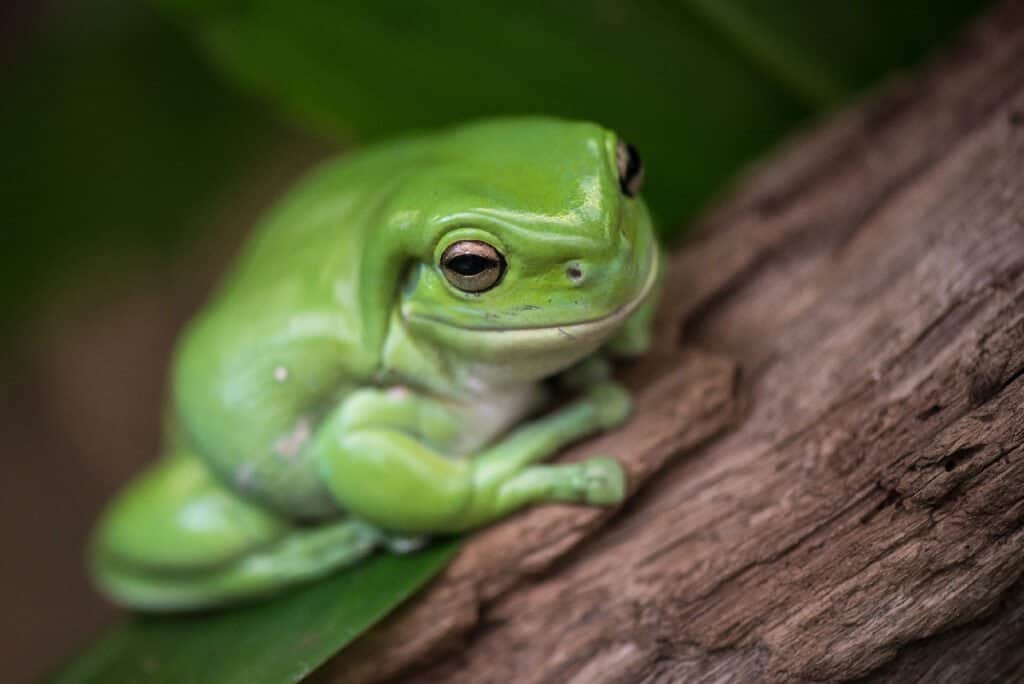
Green tree frogs are insectivores, meaning they eat minute insects like locusts, moths, and crickets.
©iStock.com/Jennifer Sophie
In Texas, green tree frogs are a common species that can dwell close to cities. Most of the time, American green tree frogs can be found in trees close to marshes, lakes, and streams. They are frequently discovered in backyard pools as well. Their geographic range extends as far east as Texas, as far north as Delaware, and as far south as the Florida Keys. The green tree frog serves as Georgia’s and Louisiana’s official state amphibian.
In North Carolina’s Piedmont and coastal plains, they are also particularly common. The frog is medium-sized, smooth-skinned, and its abdomen is plain. Its coloration ranges from light to brilliant green. Green tree frogs are insectivores, meaning they eat minute insects like locusts, moths, crickets, flies, and mosquitoes.
5. Mexican Tree Frog
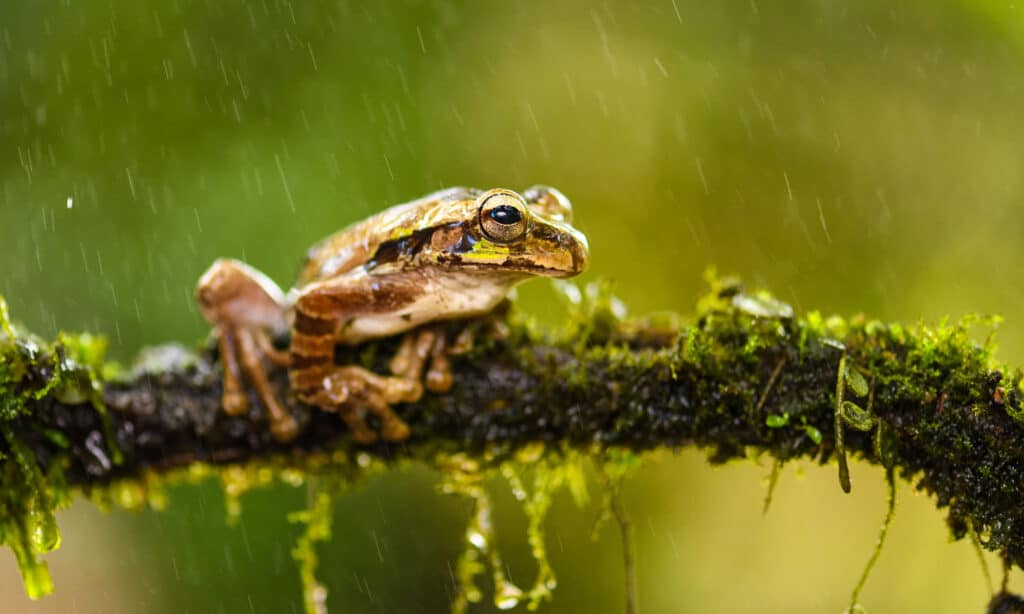
Mexican tree frogs can be found in various lowland and highland settings.
©petrdd/Shutterstock.com
The Rio Grande valley in Texas and parts of Mexico are home to the Mexican tree frog. They have dark brown spots and range in color from gray to brown. They inhabit woodlands near perennial bodies of water and wooded areas. This species is rare to see in Texas and is classed as threatened. They are nocturnal and dispersed over the world. Mexican tree frogs are extremely versatile and can be found in various lowland and highland settings, hiding under rocks to preserve moisture. In times of heavy rain, more might appear.
6. Squirrel Tree Frog

Squirrel tree frogs like damp environments with lots of food and vegetation.
©Steve Bower/Shutterstock.com
Average-sized squirrel tree frogs are found in Texas’ coastal plains and marshes. They can be any hue, including tan, green, and yellow. Most have smooth, shiny skin, while others may have blemishes. Squirrel tree frogs like damp environments with lots of food and vegetation. They can be found in backyards, pine-oak forests, hardwood forests, floodplains, and pine flat woods, as well as on trees and structures. They might even come to your porch to catch bugs drawn to the lights. They are predatory feeders who prey on insects and other invertebrates. They have been imported into the Bahamas and can be found from Texas to Virginia.
7. Spring Peeper
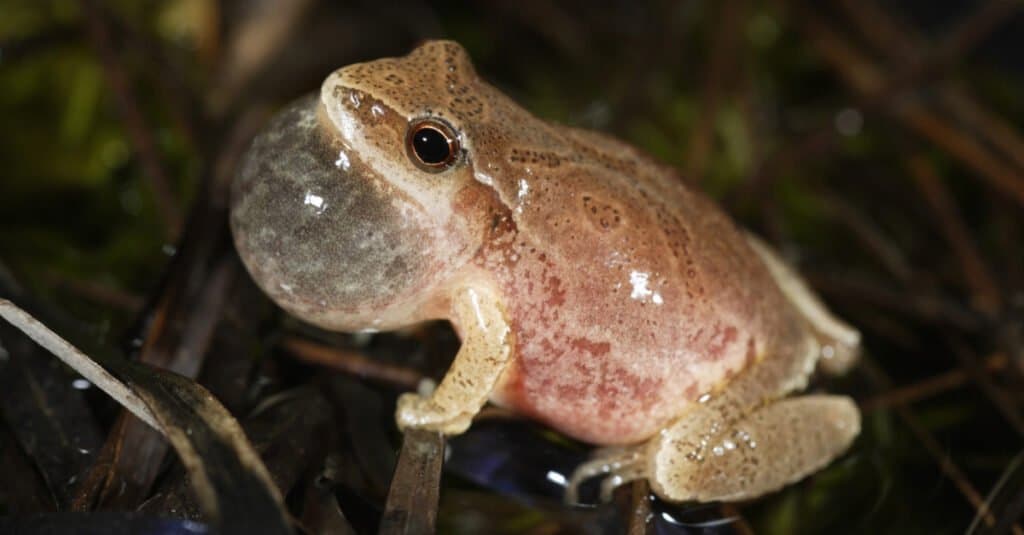
Spring peepers are nocturnal.
©Paul Tessier/Shutterstock.com
The woodlands and suburban areas of Texas and the United States are home to the spring peeper tree frog. Typically, leaves on the forest floor are where you can find spring peepers. However, they do have thick toe pads that they use for climbing trees. These little frogs, which may be found throughout eastern Texas, are among the earliest amphibians to start calling in the spring. You can find them in the spring in marshes, ponds, swamps, and other small bodies of water, where they breed and lay their eggs. The little insects that spring peepers consume include ants, spiders, flies, and beetles. They are nocturnal, and they frequently hunt among low plants.
8. Blanchard’s Cricket Frog
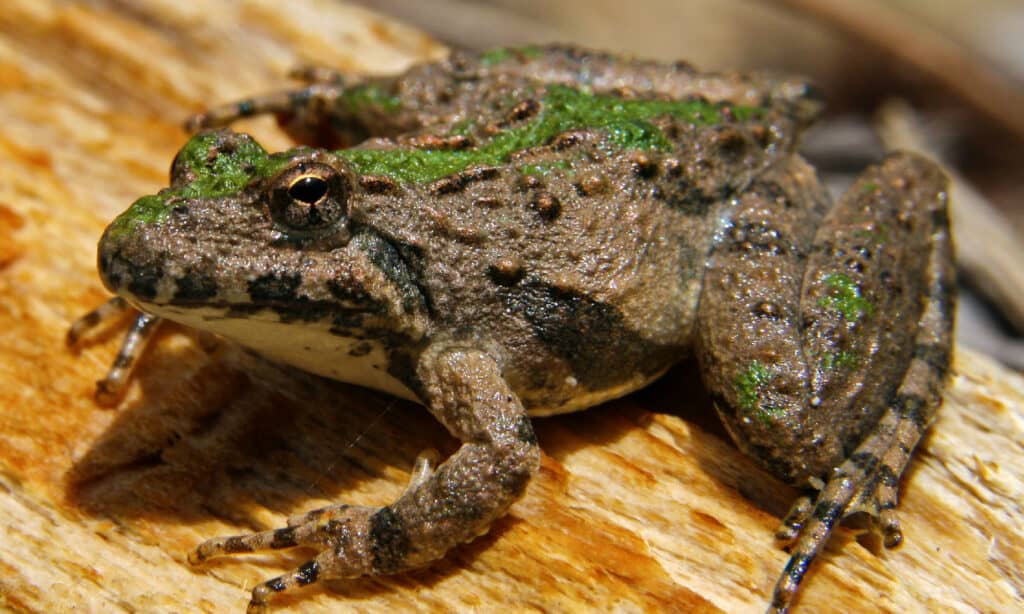
The Blanchard’s cricket frog has an average lifespan of four months.
©Ryan M. Bolton/Shutterstock.com
The Blanchard’s cricket frog can be found in most eastern parts of Texas. This tree frog can be found in or near the state’s permanent bodies of water, such as lakes, ponds, bogs, marshes, slow-moving rivers, and streams. It generates a loud knocking noise that sounds like pebbles clicking against each other. It can occasionally be seen basking in the sun and is active both day and night. This species’ legs are little and short, and they have coarse skin that is brown, tan, yellow, red, and black in hue. With an average lifespan of four months, these tree frogs are extremely fragile creatures, sadly becoming endangered and diminishing in some areas of their range.
9. Northern Cricket Frogs
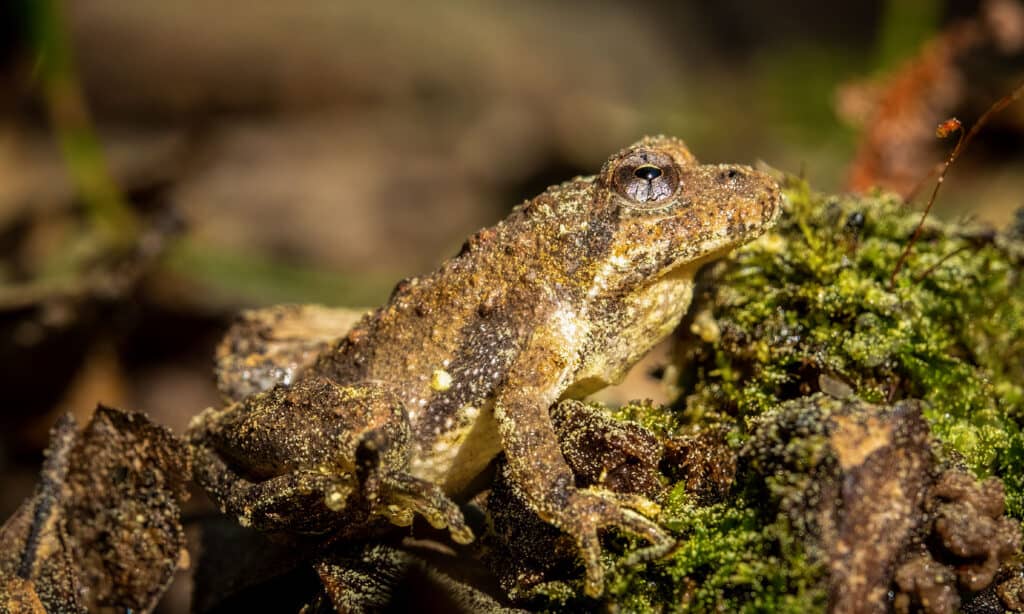
Northern tree frogs are among the smallest vertebrates in Texas.
©samray/Shutterstock.com
Despite being members of the family of tree frogs, northern cricket frogs are not arboreal and do not spend much time in trees. Typically, you can find them in ponds, lakes, and slow-moving rivers with a lot of vegetation. From New York, they can be found up to the south in Florida and the west along the Gulf Coast states in Texas and Louisiana. These tree frogs are quite small and rank among the smallest vertebrates in Texas!
10. Spotted Chorus Frog
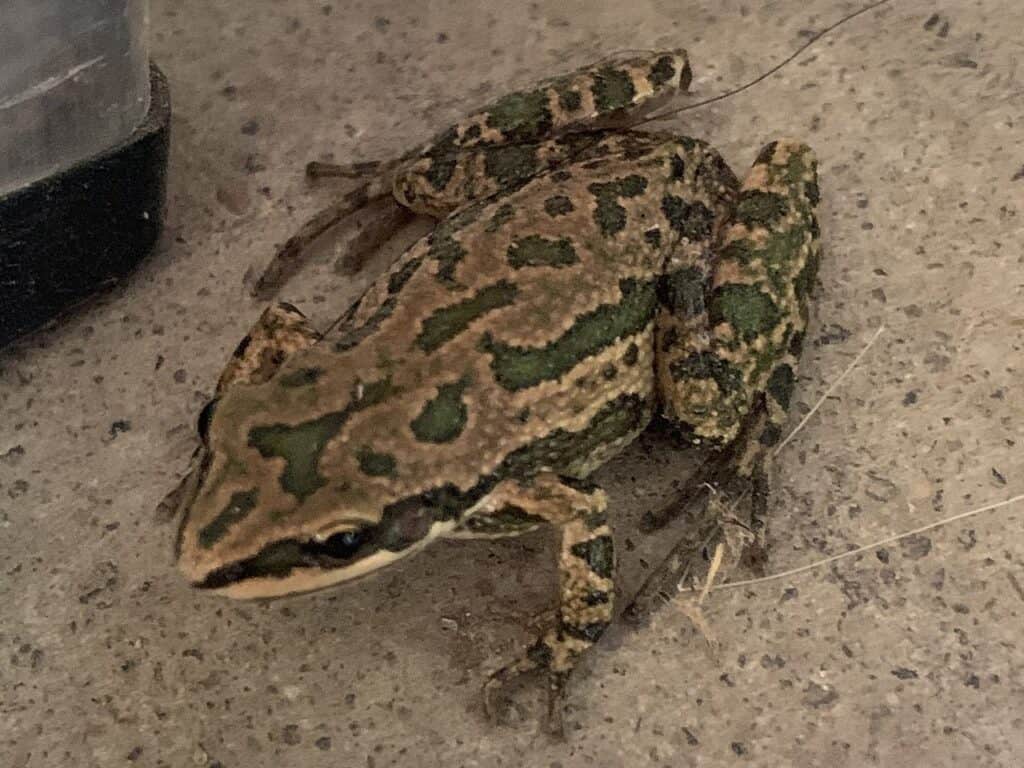
Spotted chorus frogs are often olive-green to gray with light green patches on their backs.
©Joe Brewer / CC BY 4.0 – License
Small, nocturnal, and native to the grasslands and prairies of the central United States and Tamaulipas, Mexico, is the spotted chorus frog or Clark’s tree frog. It can be found from central Kansas, northeastern Oklahoma, and northeastern New Mexico to the Rio Grande valley in Texas, Tamaulipas, and the Gulf of Mexico. These nocturnal frogs have white bellies and are often olive-green to gray in hue with light green patches on their backs. The eastern and central Panhandle, the Edwards Plateau, the Cross-Timbers area of North Texas, and the Coastal Plains are all home to the spotted chorus frog. It is frequently seen next to permanent or semi-permanent water sources, such as irrigation canals and cow tanks.
11. Strecker’s Chorus Frog

Strecker’s chorus frogs are found in separate populations in central Arkansas, southeast Missouri, and western Illinois.
©Brandy McKnight/Shutterstock.com
Most of Oklahoma and eastern Texas are home to Strecker’s chorus frogs, while a few counties in Kansas, Arkansas, and Louisiana also have neighboring populations. This nocturnal tree frog can reach a length of 1.5 inches. With black spots and a dark mark running under the eye, their color might range from brown to green to light gray. Typically, their undersides are white, with a hint of yellow or orange towards the groin. Strecker’s chorus frogs are found in separate populations in central Arkansas, southeast Missouri, and western Illinois.
12. Cajun Chorus Frog
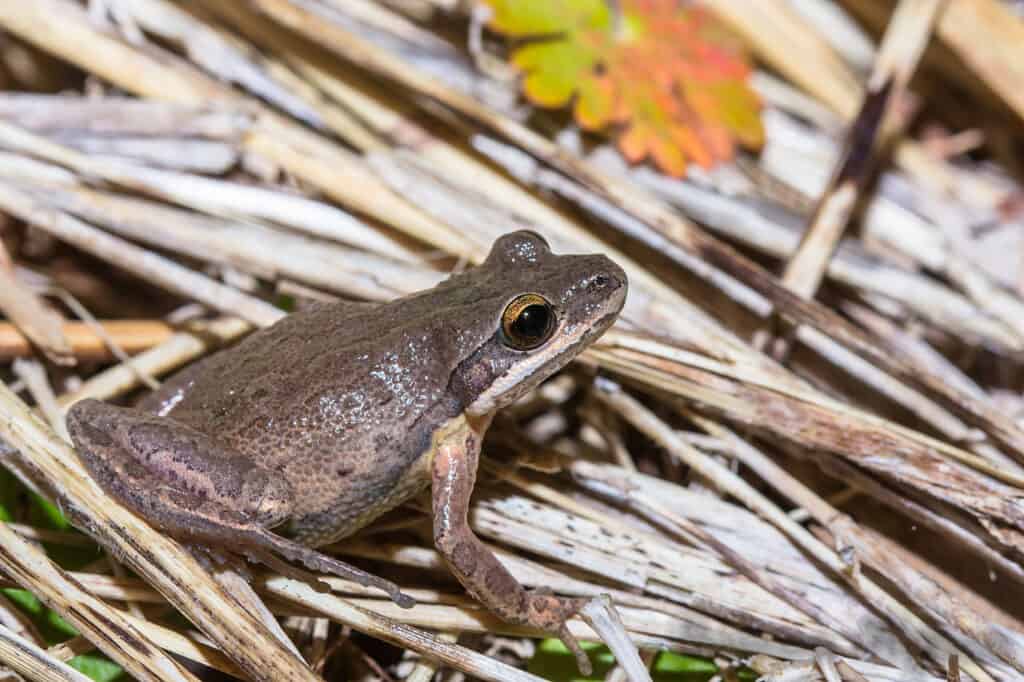
The Cajun chorus frog eats flies, beetles, and ants to stay alive.
©Jeromi Hefner / CC BY 2.0 – License
The little Cajun chorus frog species lives in the prairies and grasslands of Texas. South America is home to many Cajun chorus frogs, which are light brown with three dark brown stripes or spots across their backs. They loiter at the edges of bodies of water while calling loudly in a way that sounds like a comb being dragged. Their neck swells up when they call, usually at a rate of 20 calls per minute. The Cajun chorus frog eats flies, beetles, and ants to stay alive. These tiny nocturnal frogs are commonly found in yards.
Up Next:
Are Tree Frogs Poisonous or Dangerous?
The photo featured at the top of this post is © Joe Brewer / CC BY 4.0 – License / Original
Thank you for reading! Have some feedback for us? Contact the AZ Animals editorial team.






